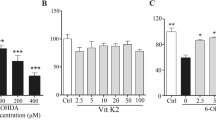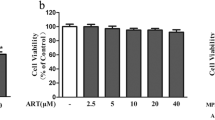Abstract
Parkinson's disease is a neurodegenerative disorder which accompanied with cognitive decline, chorei form moves and behavioral difficulties. Oxidative stress which promote the apoptotic cell death are responsible for neurodegeneration in Parkinson. The purpose of this study is to evaluate the protective effects of betanin against toxicity and oxidative damage induced by 6-hydroxydopamine (6-OHDA) and hydrogen peroxide (H2O2) in PC12 cells as an appropriate model of Parkinson's cell damage. PC12 cells pretreated with betanin (1–200 µM) for 24 h, and exposed to either 6-OHDA (100 µM) or H2O2 (150 µM) for 24 h. Cell survival and intracellular reactive oxygen species (ROS) production analyzed by resazurin and DCF-DA assay. The anti-apoptotic effects of betanin in PC12 cells were studied using flow cytometry of PI stained cells. Also, western blot analysis of survivin, Cyt c, Phospho SAPK/JNK, SAPK/JNK, Phospho-PI3 kinase P85, PI3 kinase P85 was performed for detection of apoptosis. Betanin (1–200 µM) significantly decreased the 6-OHDA and H2O2 cytotoxicity also attenuated the ROS level. Cell apoptosis significantly increased after 6-OHDA (100 µM) treatment, compared to the control. However, pretreatment with betanin (20 and 50 µM), protected against apoptosis. Western blot analysis of PC12 cells showed that 100 µM 6-OHDA could increase the proteins involved in apoptosis signaling and betanin (20 and 50 µM), could decrease the apoptosis. The results show that betanin has antioxidant and anti-apoptotic effects and may have the ability to prevent or delay the progress of neural death in Parkinson's disease.




Similar content being viewed by others
References
Jankovic J (2008) Parkinson’s disease: clinical features and diagnosis. J Neurol Neurosurg Psychiatry79:368–376
Mosley RL, Benner EJ, Kadiu I, Thomas M, Boska MD. Hasan K, Laurie C, Gendelman HE (2006) Neuroinflammation, oxidative stress, and the pathogenesis of Parkinson’s disease. Clin Neurosci Res 6:261–281
de Vries HE, Kooij G, Frenkel D, Georgopoulos S, Monsonego A, Janigro D (2012) Inflammatory events at blood–brain barrier in neuroinflammatory and neurodegenerative disorders: implications for clinical disease. Epilepsia 53:45–52
Singh S, Ahmad R, Mathur D, Sagar RK, Krishana B, Arora R, Sharma RK (2006) Neuroprotective effect of BDNF in young and aged 6-OHDA treated rat model of Parkinson disease
Hernandez-Baltazar D, Zavala-Flores LM, Villanueva-Olivo A (2017) The 6-hydroxydopamine model and parkinsonian pathophysiology: novel findings in an older model. Neurología (English Edition) 32:533–539
Dauer W, Przedborski S (2003) Parkinson's disease: mechanisms and models. Neuron 39:889–909
Ebadi M, Srinivasan SK, Baxi MD (1996) Oxidative stress and antioxidant therapy in Parkinson's disease. Prog Neurobiol 48:1–19
Stahl W, Sies H (2003) Antioxidant activity of carotenoids. Mol Aspects Med 24:345–351
Azeredo HM (2009) Betalains: properties, sources, applications, and stability—a review. Int J Food Sci Technol 44:2365–2376
Nemzer B, Pietrzkowski Z, Spórna A, Stalica P, Thresher W, Michałowski T, Wybraniec S (2001) Betalainic and nutritional profiles of pigment-enriched red beet root (Beta vulgaris L.) dried extracts. Food Chem 127:42–53
Gliszczyńska-Świgło A, Szymusiak H, Malinowska P (2006) Betanin, the main pigment of red beet: molecular origin of its exceptionally high free radical-scavenging activity. Food Addit Contam 23:1079–1087
Kujawska M, Ignatowicz E, Murias M, Ewertowska M, Mikołajczyk K, Jodynis-Liebert J (2009) Protective effect of red beetroot against carbon tetrachloride-and N-nitrosodiethylamine-induced oxidative stress in rats. J Agric Food Chem 27:2570–2575
Reddy MK, Alexander-Lindo RL, Nair MG (2005) Relative inhibition of lipid peroxidation, cyclooxygenase enzymes, and human tumor cell proliferation by natural food colors. J Agric Food Chem 53:9268–9273
Zielińska-Przyjemska M, Olejnik A, Kostrzewa A, Łuczak M, Jagodziński PP, Baer-Dubowska W (2012) The beetroot component betanin modulates ROS production, DNA damage and apoptosis in human polymorphonuclear neutrophils. Phytother Res 26:845–852
Han J, Zhang Z, Yang S, Wang J, Yang X, Tan D (2014) Betanin attenuates paraquat-induced liver toxicity through a mitochondrial pathway. Food Chem Toxicol 70:100–106
Thompson KG, Turner L, Prichard J, Dodd F, Kennedy DO, Haskell C, Blackwell JR, Jones AM (2014) Influence of dietary nitrate supplementation on physiological and cognitive responses to incremental cycle exercise. Respir Physiol Neurobiol 193:11–20
Clifford T, Howatson G, West DJ, Stevenson EJ (2015) The potential benefits of red beetroot supplementation in health and disease. Nutrients 7:2801–2822
Liu H, Mao P, Wang J, Wang T, Xie CH (2015) Allicin protects PC12 cells against 6-OHDA-induced oxidative stress and mitochondrial dysfunction via regulating mitochondrial dynamics. Cell Physiol Biochem 36:966–979
O'Brien J, Wilson I, Orton T, Pognan F (2000) Investigation of the Alamar Blue (resazurin) fluorescent dye for the assessment of mammalian cell cytotoxicity. Eur J Biochem 267:5421–5426
Liu RT, Zou LB, Lü QL (2009) Liquiritigenin inhibits Aβ 25–35-induced neurotoxicity and secretion of Aβ 1–40 in rat hippocampal neurons. Acta Pharmacol Sin 30:899
Zhang H, Wang X, You M, Liu C (1999) Water-yield relations and water-use efficiency of winter wheat in the North China Plain. Irrig Sci 19:37–45
Rahiman N, Akaberi M, Sahebkar A, Emami SA, Tayarani-Najaran Z (2018) Protective effects of saffron and its active components against oxidative stress and apoptosis in endothelial cells. Microvasc Res 118:82–89
Tayarani-Najaran Z, Makki F. Alamolhodaei NS, Mojarrab M, Emami SA (2017) Cytotoxic and apoptotic effects of different extracts of Artemisia biennis Willd. on K562 and HL-60 cell lines. IJBMS 20:166
Blum D, Torch S, Lambeng N, Nissou MF, Benabid AL, Sadoul R, Verna. JM (2001) Molecular pathways involved in the neurotoxicity of 6-OHDA, dopamine and MPTP: contribution to the apoptotic theory in Parkinson's disease. Prog Neurobiol 65:135–172
Ramazani E, Fereidoni M, Tayarani-Najaran Z (2019) Protective effects of vitamin K2 on 6-OHDA-induced apoptosis in PC12 cells through modulation bax and caspase-3 activation. Mol Biol Rep 12:1–7
Keum JW, Shin A, Gillis T, Mysore JS, Elneel KA, Lucente D, Hadzi T, Holmans P, Jones L, Orth M, Kwak S (2016) The HTT CAG-expansion mutation determines age at death but not disease duration in Huntington disease. Am J Hum Genet 98(2):287–298
Gilgun-Sherki Y, Melamed E, Offen D (2003) Antioxidant treatment in Alzheimer’s disease. J Mol Neurosci 21(1):1–1
Strack D, Vogt T, Schliemann W (2003) Recent advances in betalain research. Phytochemistry 62(3):247–269
Kanner J, Harel S, Granit R (2001) Betalains a new class of dietary cationized antioxidants. J Agric Food Chem 4 9(11):5178–5185
Tesoriere L, Butera D, Pintaudi AM, Allegra M, Livrea MA (2004) Supplementation with cactus pear (Opuntia ficus-indica) fruit decreases oxidative stress in healthy humans: a comparative study with vitamin C. Am J Clin Nutr 80:391–395
Tesoriere L, Butera D, D'arpa D, Di Gaudio F, Allegra M, Gentile C, Livrea MA (2003) Increased resistance to oxidetion of betalain-enriched human low density lipoproteins. Free Radic Res 37:689–696
Lee JH, Son CW, Kim MY, Kim MH, Kim HR, Kwak ES, Kim S, Kim MR (2009) Red beet (Beta vulgaris L.) leaf supplementation improves antioxidant status in C57BL/6J mice fed high fat high cholesterol diet. Nutr Res Pract 3:114–121
Tan D, Wang Y, Bai B, Yang X, Han J (2015) Betanin attenuates oxidative stress and inflammatory reaction in kidney of paraquat-treated rat. Food Chem Toxicol 78:141–146
Han J, Ma D, Zhang M, Yang X, Tan D (2015) Natural antioxidant betanin protects rats from paraquat-induced acute lung injury interstitial pneumonia. Biomed Res Int 2015:608174
Siriwardhana N, Shahidi F, Jeon YJ (2006) Potential antioxidative effects of cactus pear fruit (Opuntia ficus-indica) extract on radical scavenging and DNA damage reduction in human peripheral lymphocytes. J Food Lipids 13:445–458
Krajka-Kuźniak V, Paluszczak J, Szaefer H, Baer-Dubowska W (2013) Betanin, a beetroot component, induces nuclear factor erythroid-2-related factor 2-mediated expression of detoxifying/antioxidant enzymes in human liver cell lines. Br J Nutr 110(12):2138–2149
Esatbeyoglu T, Wagner AE, Motafakkerazad R, Nakajima Y, Matsugo S, Rimbach G (2014) Free radical scavenging and antioxidant activity of betanin: electron spin resonance spectroscopy studies and studies in cultured cells. Food Chem Toxicol 73:119–126
Wettasinghe M, Bolling B, Plhak L, Xiao H, Parkin K (2002) Phase II enzyme-inducing and antioxidant activities of beetroot (Beta vulgaris L.) extracts from phenotypes of different pigmentation. J Agric Food Chem 50(23):6704–6709
Wang TT, Qian XP, Liu BR (2007) Survivin: potential role in diagnosis, prognosis and targeted therapy of gastric cancer. World J Gastroenterol 13:2784
Liu X, Kim CN, Yang J, Jemmerson R, Wang X (1996) Induction of apoptotic program in cell-free extracts: requirement for dATP and cytochrome c. Cell 86:147–157
Pearson G, Robinson F, Beers Gibson T, Xu BE, Karandikar M, Berman K, Cobb MH (2001) Mitogen-activated protein (MAP) kinase pathways: regulation and physiological functions. Endocr Rev 22:153–183
Ip YT, Davis RJ (1998) Signal transduction by the c-Jun N-terminal kinase (JNK)—from inflammation to development. Curr Opin Cell Biol 10:205–219
Griffin RJ, Moloney A, Kelliher M, Johnston JA, Ravid R, Dockery P, O’connor R, O’neill C (2005) Activation of Akt/PKB, increased phosphorylation of Akt substrates and loss and altered distribution of Akt and PTEN are features of Alzheimer's disease pathology. J Neurochem 93:105–117
Acknowledgements
The authors would like to thank Mr. Malaeke for assistance in the flow cytometry of samples.
Funding
This work has been supported by Grant No. 3/42879 from Ferdowsi University of Mashhad, Mashhad, Iran and Grant No. 951766 from Research Affairs of Mashhad University of Medical Sciences, Mashhad, Iran.
Author information
Authors and Affiliations
Contributions
EH performed the experiments and wrote the manuscript. MF and ZT-N conceived, designed, and supervised the project, wrote the manuscript nd provided financial support.
Corresponding author
Ethics declarations
Conflict of interest
There is no conflict of interest in this study.
Ethics Approval
As this work is carried out in PC12 cells, there is no need for ethical clearance.
Additional information
Publisher's Note
Springer Nature remains neutral with regard to jurisdictional claims in published maps and institutional affiliations.
Rights and permissions
About this article
Cite this article
Hadipour, E., Fereidoni, M. & Tayarani-Najaran, Z. Betanin Attenuates Oxidative Stress Induced by 6-OHDA in PC12 Cells via SAPK/JNK and PI3 K Pathways. Neurochem Res 45, 395–403 (2020). https://doi.org/10.1007/s11064-019-02927-w
Received:
Revised:
Accepted:
Published:
Issue Date:
DOI: https://doi.org/10.1007/s11064-019-02927-w




